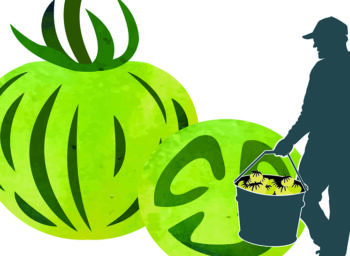What is the meaning of fifty cents? In today’s world, two quarters might get you a stick of gum, a postage stamp, or one small piece of fruit. Weighed against the national minimum wage of $7.25 per hour, fifty cents are equivalent to a little over four minutes of work. For a farmworker, however, fifty cents mean something entirely different.

Blog: Sourcing
+ Blog Categories

Introducing our Newly Updated Food Waste Commitments for 2024
- Blog
We’re no strangers to fighting food waste at Bon Appétit – we’ve been finding ways to keep food out of landfills since we opened our doors. Our most exciting step toward fighting food waste in our kitchens was the creation of Waste Not™ in 2021, our proprietary waste tracking system created by chefs, for chefs. Now we are excited to introduce our newly upgraded companywide waste commitments, which will help us meet our broader goal of reducing food loss and waste nationally by 50% by 2030, which we first pledged to work toward in 2016.

Celebrating Progress and Recognizing Continued Struggles for Farmworkers’ Rights
- Blog
While many food labels you might find in the grocery store provide insight on a farm’s environmental approach or treatment of animals (think: USDA Certified Organic or Certified Humane), few give meaningful insight on the ways farmworkers are compensated or treated. This is where programs like the Fair Food Program (FFP) and the Equitable Food Initiative (EFI) come in.

Looking Back on Bon Appétit’s Decades of Support for Farmworkers’ Rights
- Blog
After almost two decades of boycotting, marching, educating, researching, and signing onto commitments, Bon Appétit Management Company is proud to reflect on progress made while continuing the fight for farmworkers’ rights.

Have Brine, Will Travel: Pickling Pop-ups with the Fellows
- Blog
As Bon Appétit Fellows, part of our job is to travel to the different campuses we serve and collaborate with our culinary teams, along with university staff and student clubs, to engage students and inspire the next generation of sustainable food lovers and advocates. It’s always fun to get hands-on, of course, which is why we designed our quick pickling demo.

A Note From Fedele Bauccio: Sustainability is Everyone’s Job
We believe that it takes more than one person or one siloed team in a company to truly make sustainability a core operating principle. From our wellness and purchasing teams to our managers and cooks in the field, we strive for sustainability to be second nature across every level of our company.

An Update from Our Holiday Grantees, the Labour Protection Network
- Blog
Every year at the holidays Bon Appétit Management Company presents our clients with a gift we’ve made on their behalf to an organization whose work aligns with our social and/or environmental values. We support fair treatment for all workers, so in 2023, we donated to the Labour Protection Network (LPN), a non-profit organization dedicated to promoting and protecting the rights of workers in various industries, including the fishing industry.

From Koginut to Kabocha: Tasting the Rich Diversity of Winter Squash
- Blog
As winter’s chill settles in, cooks often turn to storage crops, including a vibrant array of hardy winter squash, each with its own special flavor profile and gastronomic potential. From the robust and well-known butternut to the delicately sweet acorn, ornamental turban squash, and velvety texture and nutty flavor of Koginut, these nutrient-rich and flavor-packed vegetables define the essence of the season.

The Team at Butler University Unveils a Beautiful New Café
- Blog
After being under construction for the fall semester, the café that formerly occupied Butler’s Residential College (ResCo) is back with a new look and feel, many new amenities and plenty of old favorites, and a new name – Midtown Provisions.

So Mush Room in Our Hearts (for ‘Shrooms)
- Blog
Mushrooms are having a moment. With a rise in mushroom-themed art, beauty, fashion, film, and culinary and wellness explorations, mushrooms’ popularity has risen exponentially in recent years. The collective fondness for ‘shrooms includes many of those on the college campuses we serve.
